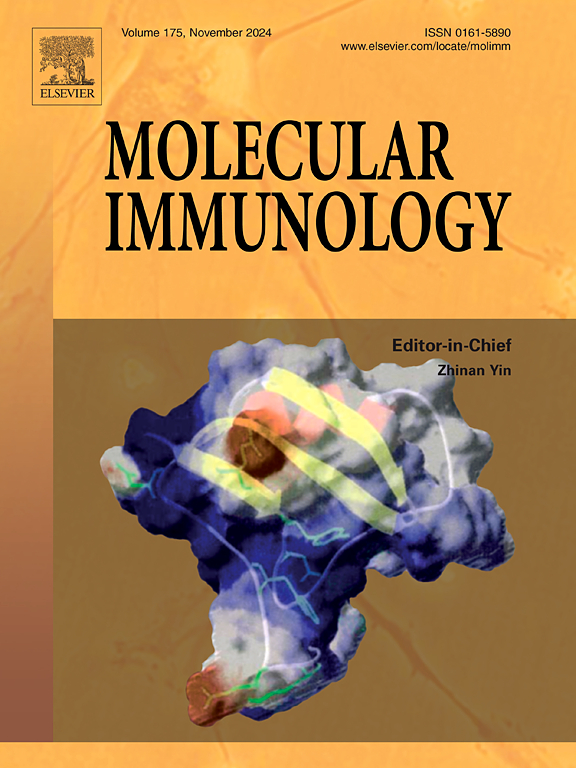Ovalbumin alters DAF-16 Class-II/I gene expressions via insulin/insulin-like growth factor-1 signaling to initiate the innate immune response of Caenorhabditis elegans
IF 3.2
3区 医学
Q2 BIOCHEMISTRY & MOLECULAR BIOLOGY
引用次数: 0
Abstract
Innate immunity, as a significant defense system of the body, plays a key role in allergic reactions, but the mechanism of how food allergens trigger innate immune signaling is still unclear. Ovalbumin (OVA) is a model allergen in food allergy studies. Previous studies by our group have demonstrated that the innate immunity of Caenorhabditis elegans (C. elegans) elicited by OVA treatment was related to the insulin/insulin-like growth factor-1 signaling (IIS) pathway, but the details remain unknown. Therefore, in this study, the molecular mechanism of innate immune signaling transduction of C. elegans stimulated by OVA was determined using genetic mutations as well as RT-PCR, GFP fluorescence visualization monitoring, and slow-killing experiments. Results showed that the expression levels of DAF-16-class-I/II genes in the IIS pathway were significantly changed in C. elegans after OVA treatment, and the upstream gene daf-2 played an important role, which up-regulated the levels of DAF-16-class-II genes dod-22 and F55G11.8 by the daf-2-pqm-1 pathway, and down-regulated the level of DAF-16-class-I gene thn-2 by the daf-2-daf-16 pathway. Moreover, the upstream genes daf-2 and nhr-14, and the transcription factors DAF-16, PQM-1, and SKN-1 in the IIS pathway all participated in the up-regulations of DAF-16-class-II genes dod-17, dod-24, and F55G11.2. In conclusion, details of OVA activating innate immunity in C. elegans through the IIS pathway are reported here, and the results can be further extrapolated to mammals, which will contribute to a better understanding of the mechanism of the occurrence of food allergic reactions from the perspective of innate immunity.
卵清蛋白通过胰岛素/胰岛素样生长因子-1信号通路改变DAF-16 ii /I类基因表达,启动秀丽隐杆线虫的先天免疫应答
先天免疫作为机体重要的防御系统,在过敏反应中起着关键作用,但食物过敏原如何触发先天免疫信号的机制尚不清楚。卵清蛋白(OVA)是食物过敏研究中的典型过敏原。本课题组前期研究表明,卵细胞治疗引起秀丽隐杆线虫(C. elegans)先天免疫与胰岛素/胰岛素样生长因子-1信号通路(IIS)有关,但细节尚不清楚。因此,本研究采用基因突变、RT-PCR、GFP荧光可视化监测、慢杀实验等方法,研究了虫卵刺激秀丽隐杆线虫先天免疫信号转导的分子机制。结果显示,经OVA处理后,秀丽线虫IIS通路中daf-16类i /II基因的表达水平发生了显著变化,其中上游基因daf-2发挥了重要作用,通过daf-2-pqm-1通路上调daf-16类II基因dd -22和F55G11.8的表达水平,通过daf-2-daf-16通路下调daf-16类i基因thn-2的表达水平。此外,IIS通路上游基因daf-2、nhr-14以及转录因子DAF-16、PQM-1、SKN-1均参与了DAF-16ⅱ类基因dodd -17、dodd -24、F55G11.2的上调。综上所述,本文报道了虫卵通过IIS途径激活秀丽隐杆线虫先天免疫的细节,并将结果进一步外推到哺乳动物中,有助于从先天免疫的角度更好地理解食物过敏反应发生的机制。
本文章由计算机程序翻译,如有差异,请以英文原文为准。
求助全文
约1分钟内获得全文
求助全文
来源期刊

Molecular immunology
医学-免疫学
CiteScore
6.90
自引率
2.80%
发文量
324
审稿时长
50 days
期刊介绍:
Molecular Immunology publishes original articles, reviews and commentaries on all areas of immunology, with a particular focus on description of cellular, biochemical or genetic mechanisms underlying immunological phenomena. Studies on all model organisms, from invertebrates to humans, are suitable. Examples include, but are not restricted to:
Infection, autoimmunity, transplantation, immunodeficiencies, inflammation and tumor immunology
Mechanisms of induction, regulation and termination of innate and adaptive immunity
Intercellular communication, cooperation and regulation
Intracellular mechanisms of immunity (endocytosis, protein trafficking, pathogen recognition, antigen presentation, etc)
Mechanisms of action of the cells and molecules of the immune system
Structural analysis
Development of the immune system
Comparative immunology and evolution of the immune system
"Omics" studies and bioinformatics
Vaccines, biotechnology and therapeutic manipulation of the immune system (therapeutic antibodies, cytokines, cellular therapies, etc)
Technical developments.
 求助内容:
求助内容: 应助结果提醒方式:
应助结果提醒方式:


